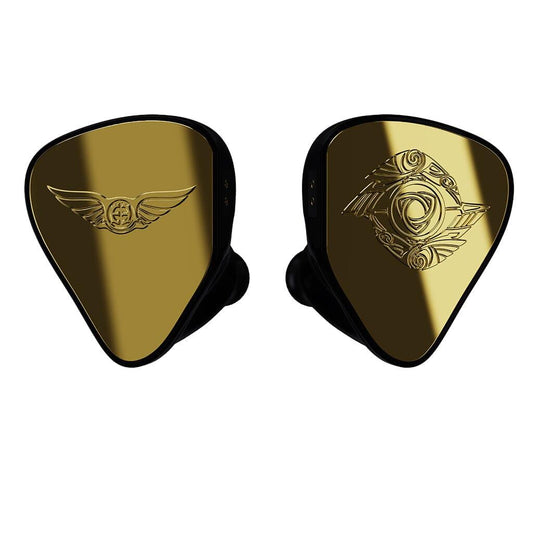Empire Ears Raven Review - Hefty in More Ways than One
The Raven is Empire Ear's current TOTL flagship IEM. The flagship landscape has become increasingly competitive; however, it seems like many IEMs aggregate on a similar style of tuning. Precogvision takes a look at how the Raven circumvents this new trend.

Introduction
Empire Ear’s Raven is a 2DD/5BA/1BC/4EST setup that will run you a hefty $3600. At the moment, it stands as Empire Ear’s flagship IEM, replacing the Wraith (which seems discontinued and solely available as B-stock).
For a little more context, I briefly listened to this IEM over a year ago while on vacation in Singapore. I liked what I heard in that short period, but I was surrounded with a lot of other great IEMs which made it difficult to stand out. The Raven fell even further off my radar following a recall due to an unexpected manufacturing defect.
Then I heard it again at CanJam NYC 2024 and SoCal 2024, and my interest was reignited. So where does the Raven stand now that I’ve listened to it extensively from the comfort of my home? Let’s take a closer listen.
This unit was provided for review by Headphones.com. It will be returned at the end of the review period. As always, what follows are my honest thoughts and opinions to the best of my ability.
Empire Ears Raven In-Ear Headphones

The included puck case sports a leather exterior and a felt-lined interior. It’s a nice case; however, I wish Empire Ear’s aluminum puck case had been included instead. The previous aluminum puck case was my gold standard for puck cases: it was exceptionally robust, had great threading, and had a unique rubber interior (which made cleaning the case a boon). The Raven’s case is more reminiscent of the generic case you’d get with a lot of other IEMs.

I’m pretty ambivalent about the Raven’s cable. It’s another PW Audio cable; regular readers might recall that I’ve never liked this brand’s cables. I’ve found most of them to be extraordinarily overpriced, to have poor tolerances, and to be unwieldy. This cable - designated the R7, the ‘seven’ representing iterations of development - is honestly fine. Microphonics are decently controlled, the wires are pliable, and the chin slider could use more tension but works in practice.

Moving to the Raven itself, the Raven features a straightforward design: black resin shells adorned with a 316L stainless steel faceplate. Depending on the edition of the Raven, the faceplate will either be gold (for the launch edition) or black (for the standard edition). The faceplate features engravings of Empire Ear’s logo and the eye of Odin.

Something that needs to be highlighted is the sheer size of the Raven. It is one of the largest IEMs that I’ve handled, likely owing to the small army of drivers packed inside. This is not the IEM for you if you’re someone with smaller ears. That said, I found the Raven to be surprisingly comfortable - the shell is pleasingly ergonomic despite the size - and I was able to wear it for a couple hours before discomfort cropped up.
Sound Analysis
Below is a graph of the Empire Ears Raven measured using the ear canal simulator of the B&K Type 5128 (designated Type 4620). It is calibrated to the 4620 + Human Diffuse Field HRTF. The bounds behind the measurement are the bounds of preference outlined in the existing speaker and headphone literature from Harman.
In the past, I’ve associated Empire Ear’s IEMs with V and L-shaped tunings, where emphasis is placed on bombastic bass and exciting treble accordingly. However, the brand’s sound has begun shifting in recent years. The Odin showcased something much closer to neutral-with-bass-boost. Then, notably, Empire Ear’s collaboration pieces with Astell&Kern, the Odyssey and Novus, illustrated an unorthodox yet tasteful style of tuning.
The Raven falls much closer to the latter collaboration pieces. Starting from the bottom, the Raven’s bass is generously boosted about ~10dB over 1kHz. There’s some extra kick at around 300-400Hz, lending to fairly dense bass transients and plenty of ‘thump’ while circumventing ‘fart’ territory. Attack transients are slightly blunted and decay is pleasingly extended. In general, there’s a sense of this being the type of bass that you’d hear in the club - it leans more fun - but with a tasteful leash to appeal to audiophile sensibilities.
Moving upwards, the Raven continues to play off this trend with a pinna gently notched at 2kHz and a slightly veiled 3-5kHz region. These are tuning decisions that we often associate with a more colored presentation. In listening, then, vocals come across thicker and more saturated while being placed on the soundstage larger-than-life.
The most interesting part about this midrange, though, would be the texture. I suspect this is facilitated by the bone conduction drivers and a slight indentation at 500Hz. It creates a subtle, but noticeable, reverberation to vocals that spreads around the center image. It’s a treat to hear especially on tracks with breathy vocals. And really, for an Empire Ear’s IEM - which are usually known for their bass - I find myself glued to the Raven’s midrange a lot more than I’d expect.
Moving into the treble, this is what I would consider the Raven’s biggest weakness. It has a strong emphasis on lower-treble, leading to a distinctive, dry “chhh” on percussive hits. As a listener who‘s never been particularly concerned with accuracy, it doesn’t bother me on most tracks. Nonetheless, it can be somewhat fatiguing at louder volumes, and I wish that the Raven’s 5-6kHz region was lowered by about 1-2dB or its upper-treble (15kHz) was boosted by that same amount (preferably the latter). Outside of this, I find the Raven’s treble to be fairly palatable: well-extended and without other noticeable peaking.

Subjective Performance
I need to disclaim that claims of soundstage are often grossly exaggerated, and I encourage everyone to read this excellent article by Listener if they haven’t already.
With that being said, I have listened to hundreds of IEMs - it’s all a blur at this point - so it’s pretty rare that an IEM stands out to me in this department. And in this vein, the Raven has excellent lateral width to its stage, top-tier layering, and notably, a strong sense of center image (the illusion of a ‘third’ speaker being played from the center of the stage). It’s hard for me to say where it stacks up exactly against other IEMs in this department, but it’s reminiscent of my listening experience with standouts for imaging like the 64 Audio Fourte and Campfire Andromeda 2020.
Detail on the Raven is an interesting case study. The Raven has slightly blunted attack transients in the bass and the midrange; this is mostly a product of its strongly boosted bass and recessed upper-midrange. However, I wouldn’t hesitate to attest that it still sounds extremely detailed. Notes are imaged quite largely on the stage, especially in the midrange, making it easy to focus on them. Textures and reverb trails also pop readily, owing to the Raven’s solid treble extension and unique tuning.
I think that most people who listen to the Raven will recognize that it’s not an accurate representation of what music sounds like in real-life. However, many of the best IEMs aim to present music on their own terms and to exceed the limitations of what accuracy can get you. Whether the Raven actually succeeds at this is more debatable, but this is the general tuning ethos of the Raven to my ears.
Along these lines, I would say that the timbre of the Raven is fairly unnatural, but not necessarily in a bad way. There’s no ‘grain’ to notes or metallic sheen outside of the lower-treble. The biggest knock I’d have is coherency. There’s clear distinctions between the Raven’s bass, midrange, and treble wherein it sounds like they’re being handled by different driver types. This may or may not bother some listeners; in any event, the presentation of the Raven is undoubtedly what makes it stand out.
Comparisons
I recently got an Elysian Annihilator 2023 in. Given that it’s one of my top IEMs, and it’s comparably priced to the Raven, I thought it made a good point of comparison.
The biggest distinction between these IEMs lies in their presentation. Elysian seemingly has a more conventional take on what qualifies detail, and this is realized through the Annihilator’s thinner midrange and nearly linear treble response. As a result of its thinner sound, for the most part, this does mean that the Annihilator sounds sharper, faster and more detailed than the Raven.
On the other hand, when it comes to a sense of staging, I find the Annihilator to sound significantly more narrow than the Raven. On the Annihilator, it’s almost like instruments have defined pockets to them on the stage, and they don’t resonate to create a spherical, “holographic” experience compared to the Raven.
Overall, I see the Annihilator and Raven as distinct expressions of what qualifies high-fidelity sound. The Annihilator takes a more conventional approach to a very high degree. On the other hand, the Raven throws the playbook out the window and tries to do something unique that, metaphorically, results in higher highs and lower lows. On a hip-hop track like Filthy the Kid's "5th Avenue", which is slightly darker, bass-y, and male vocal-oriented, I prefer the Raven. On something more female vocal dominated, and that benefits from clarity, I would prefer the Annihilator.
The Bottom Line
The Raven is one of the small subset of IEMs that keeps me still hooked on this hobby. It’s a challenge to the modern-tuning orthodoxy that is genuinely interesting to write about and to hear. In my opinion, the IEMs that make up the top echelons of the IEM world are defined by having character, which the Raven has no shortage of.
But as for whether I’d recommend the Raven, I’d have to leave it at ‘possibly’. The Raven reminds me a lot of the 64 Audio Fourte with the Fourte’s world-class technical performance circumscribed by less-than-world-class tuning. It’s an IEM that will polarize from its fit to its sound, and I’d recommend any potential buyers to demo it beforehand.

